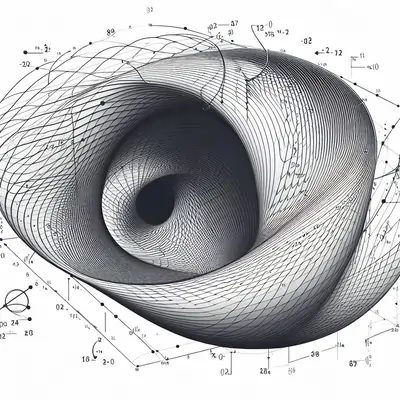A Comprehensive Journey: Computing Curvature in Higher Dimensions Using Frenet-Serret

Understanding the curvature of a curve in higher dimensions is a crucial concept in advanced mathematics and has profound implications in various fields such as physics, engineering, and computer science. In this blog, we delve into the theoretical intricacies of computing curvature using the Frenet-Serret formulas. This discussion aims to provide university students with a comprehensive guide on how to write their calculus assignment related to this intriguing topic.
Setting the Stage: Curvature in Multidimensional Spaces
In the realm of multidimensional spaces, understanding curvature transcends the familiar landscapes of two and three dimensions. Curvature, at its essence, quantifies how sharply a curve bends at a specific point. This fundamental concept, when applied to higher dimensions, demands a recalibration of mathematical intuition. To embark on this intellectual journey, we must introduce additional tools and perspectives, broadening our understanding of curvature's manifestation in complex, multidimensional spaces.
The extension to higher dimensions prompts a departure from the intuitive visualizations of curvature in 2D and 3D spaces. Instead, it beckons the exploration of abstract spaces where curves can bend and twist in ways not easily perceptible to our three-dimensional sensibilities. This introduction lays the groundwork for a more profound exploration of the mathematics of curvature, providing the necessary context for the subsequent discussion on the Frenet-Serret formulas.

The Frenet-Serret Formulas: A Multidimensional Approach
The Frenet-Serret formulas, initially conceived for curves in three-dimensional Euclidean space, emerge as powerful tools for the computation of curvature. These formulas, which have found profound applications in differential geometry, calculus, and physics, offer a robust framework for navigating the intricacies of curved paths in space.
This section serves as a gateway to extending the applicability of Frenet-Serret beyond the familiar three dimensions. We embark on an exploration of the mathematical underpinnings that facilitate this extension, unravelling the complexities of adapting these formulas to higher dimensions. By doing so, we bridge the conceptual gap between the classical understanding of curves and the nuanced environment of multidimensional spaces.
Tangent Vectors and Osculating Hyperplanes: Foundation of Frenet-Serret Formulas
At the heart of the Frenet-Serret formulas lie two fundamental concepts: tangent vectors and osculating hyperplanes. These elements serve as the bedrock for comprehending the evolving direction of a curve in higher-dimensional spaces. The dissection of these concepts involves a careful examination of how tangent vectors capture the instantaneous direction of the curve, and osculating hyperplanes elucidate the plane that best fits the curve at a given point.
By delving into the geometry of these foundational elements, we illuminate their role in discerning the intricate dynamics of curves as they traverse multidimensional spaces. This section acts as a crucial stepping stone for students, providing a deepened understanding of the geometric principles that govern the behaviour of curves.
Parametric Representation: Navigating Curves in Multiple Dimensions
To apply the Frenet-Serret formulas effectively, a parametric representation of the curve becomes indispensable. This segment of the discussion navigates through the intricacies of representing curves in higher dimensions using parametric equations. We explore the importance of parametric representations in the context of Frenet-Serret, establishing them as the linguistic bridge that connects the abstract notions of curvature with concrete mathematical formulations.
Understanding how to parametrically represent curves in higher dimensions is akin to learning a new language. It empowers students to articulate the behaviour of curves with precision, providing the syntactic foundation for subsequent applications of the Frenet-Serret formulas.
Deriving the Frenet-Serret Formulas in Higher Dimensions
Having established the prerequisites, we ascend to the pinnacle of this theoretical expedition: the derivation of the Frenet-Serret formulas in higher dimensions. This intricate process involves a step-by-step exploration of the tangential, normal, and binormal vectors. As we navigate through this derivation, we unravel the complex relationships that bind these vectors together, shedding light on their collective role in defining curvature in higher-dimensional spaces.
The derivation serves as the synthesis of the concepts introduced earlier, weaving together tangent vectors, osculating hyperplanes, and parametric representations into a comprehensive framework for computing curvature. Through this process, students are not only equipped with a formal method for calculating curvature but also gain a profound appreciation for the elegance and depth of the underlying mathematical structures.
Interpreting Curvature Components: Insight into Multidimensional Curvature
Armed with the Frenet-Serret formulas, the exploration delves into the intricate components that contribute to curvature in higher dimensions. Each vector—tangential, normal, and binormal—plays a pivotal role in shaping the trajectory of a curve. By dissecting the significance of each vector, we gain profound insights into the nuanced interplay that defines the curvature of a curve in multidimensional spaces.
The tangential vector captures the instantaneous direction of the curve, steering us through the local geometry of the path. The normal vector, orthogonal to the tangential vector, points toward the centre of curvature, unveiling the curvature's magnitude. The binormal vector completes this trio, representing the axis around which the curve twists and turns in three-dimensional space.
Understanding the symbiotic relationship between these vectors unlocks a deeper comprehension of how curves behave in higher dimensions. This section serves as a bridge between the abstract mathematical formulation of the Frenet-Serret formulas and the tangible, geometric consequences of these formulas on the curvature of a curve.
Applications in Real-World Scenarios: Connecting Theory to Practice
To breathe life into the theoretical framework, we transition from abstract concepts to real-world applications. The Frenet-Serret formulas find practical utility in a myriad of scenarios, with a particular focus on applications in physics. One compelling example is the motion of celestial bodies, where understanding the curvature of their trajectories is pivotal.
By examining such applications, students can bridge the gap between theoretical abstractions and tangible phenomena. The motion of planets and satellites in space provides a concrete context for applying the Frenet-Serret formulas. This not only reinforces the importance of theoretical concepts but also highlights the broader implications and significance of understanding curvature in higher dimensions.
Challenges and Advanced Topics: Navigating Beyond the Basics
As we approach the conclusion of our theoretical discussion, it is crucial to acknowledge the challenges that may arise when computing curvature in higher dimensions. This section serves as a reality check, addressing potential pitfalls and complexities that students may encounter. Challenges could include intricate mathematical computations, conceptual hurdles in visualizing higher-dimensional spaces, or practical difficulties in applying the formulas to real-world datasets.
Furthermore, we provide a glimpse into advanced topics, encouraging students to embark on a journey of continued exploration. Higher-dimensional curvature is a rich field with ongoing research and applications, such as in computer graphics, robotics, and artificial intelligence. By delving into these advanced topics, students can deepen their understanding and appreciate the evolving landscape of multidimensional curvature.
Conclusion:
In this theoretical exploration, we've navigated the intricate terrain of computing curvature in higher dimensions using the Frenet-Serret formulas. By unravelling the mathematical foundations and exploring real-world applications, this blog aims to empower university students to solve their maths assignments related to this fascinating topic with confidence and clarity. As we conclude, the journey doesn't end here; it merely marks the beginning of a deeper understanding of multidimensional curvature and its diverse implications.